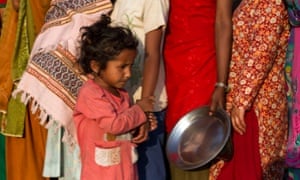Child Trafficking in Nepal
"This is a bad time during the emergency; trafficking is a problem. Watch out for unaccompanied kids."
"If you're suspicious call this number."
Child trafficking alert, Siundhupalchok, Nepal
"Watch out for people who give you false dreams of education, food, jobs. Don't believe it. They're taking advantage of our honesty."
"Are you alone? Who is with you?"
Sangeet Girio, handling out pamphlets, Shakti Samua group
"These kids were told they were going to school in India. They were genuinely excited about leaving home and getting an education and a chance for a better life."
"But when asked where they wrote the entrance exam, they didn't know anything about it."
"We have 600 registered care homes (orphanages) in Nepal. The requests to open more after the earthquake have tripled. Some of them are in fact scams for religions that are using the kids to raise money."
"In the name of children, these people are stealing money."
Tarak Dhital, executive director, Central Child Welfare Board, Kathmandu

Where some NGOs rush in to aid at times of national catastrophes to help bring a country back to a state of normalcy, other groups also rush in, to take advantage of the havoc and the desperate plight of people in shock. In Nepal, destroyed homes, collapsed schools and dead parents leaving behind orphans create the perfect junction for human traffickers to move in and ply their odious trade; this time in corralling for their nefarious purposes children left in desperate straits.
The United Nations has estimated that twelve to fifteen thousand girls are victimized by human traffickers in Nepal every year. The pace has accelerated with the advent of this new tragedy in an already beleaguered country and society. The trafficked girls end up in India, in South Korea and South Africa. Humanitarian agencies, recognizing the plight of these children, joined forces in a scheme meant to rescue children before they are taken out of the country.
A local child rescue group, Shakti Samua, has volunteers waiting at bus stops in Sindhupalchok, the district known for representing the highest rate of trafficking of children. An intersection of switchback roads in Bandeu is the venue where buses and trucks drive out of the mountains on their way to Kathmandu. The bus stop is monitored by local police. The volunteers with the charity await their opportunity to board the buses as they stop to let off passengers or take them on, pamphlets at the ready for hand-outs.
Travellers sit three to a seat on the buses, the aisles are packed. The volunteer boarding swiftly with the handout pamphlets explaining the crisis in human trafficking of vulnerable Nepalese children knows there is a mere pause available before the bus resumes its journey; they must speak quickly, delivering the essence of the message, and scattering the pamphlets among the passengers to alert them to the situation, then disembark and wait for the next buses to arrive.
At one stop in the Kathmandu Valley, 19 children; eleven boys and eight girls between the ages of ten and thirteen from Dolakha, were rescued from three men from India. The parents of the children were called and informed that their children were meant to be sold by the traffickers, and not, as the parents and the children believed, taken to safe houses where access to good schools would be made available to them. They are sometimes sold as slave labourers. The children were returned to their parents.
Another 45 children placed in a similar plight were rescued as well. The Nepalese government on May 26 brought forward a new law, that children under 16 are not permitted to travel without a parent or another adult approved by the district's child welfare board, outside their home district. International adoptions have been halted until September. Radio advertisements warn the public: "Trafficking is a problem. Keep your kids close."
Poor families in the mountains had been convinced by unscrupulously smooth talkers that their children would be exposed to a good education and better food than they could give them if they were placed in a care home in Kathmandu. The children ended up stuffed ten to a room, fed paltry quantities that led them to scavenge for food on the streets. But they were used in a campaign asking for charity to give them a better life.
"We have rescued 26 children from the clutches of human traffickers in the past 20 days and sent them to rehabilitation centres."
"Following the Nepal disaster, the fear of children and women falling prey to the human trafficker gangs has increased manifold and so we are keeping a strict vigil along the Indo-Nepal border to prevent such happenings."
Sanjeev Kumar, senior labour official, Bihar’s East Champaran district, India.
Labels: Child Welfare, Earthquake, Natural Disaster, Nepal

0 Comments:
Post a Comment
<< Home